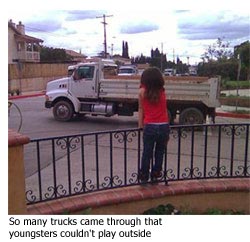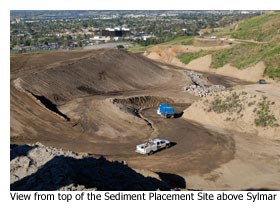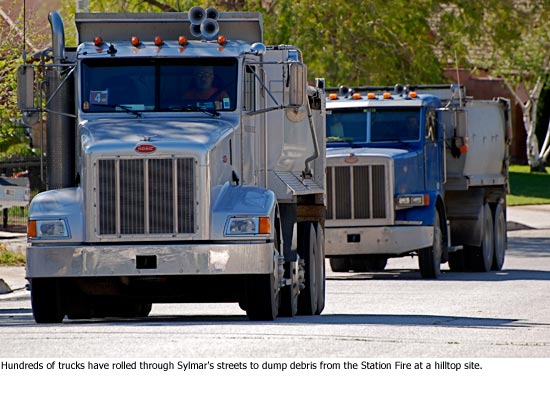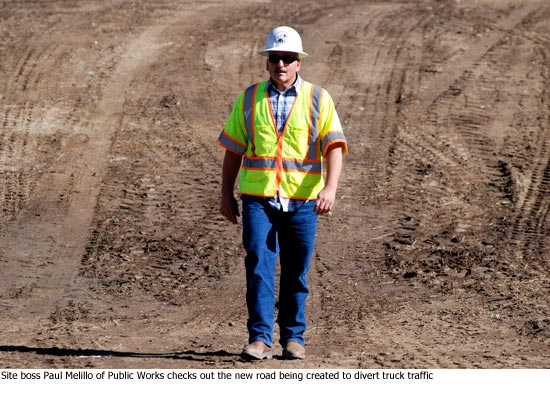These streets weren’t made for truckin’
April 8, 2010
First came the rains. Then came the trucks, hundreds of them suddenly rumbling through a sleepy Sylmar neighborhood.
They arrived at a staggering clip of 250 an hour, hauling tons of dirt that had cascaded down hillsides scorched by the Station Fire and into rapidly filling debris basins. Bumper to bumper, the trucks inched through the residential streets and up a private road to an obscure L.A. County “sediment disposal site.”
Then they headed back 20 miles across town for more loads—day after day, week after week, from 7 a.m. to 7 p.m.
The goal was to make sure no lives or homes were lost to mudslides that could result from overflowing debris basins in La Crescenta and La Canada Flintridge, the communities most impacted by last year’s blaze. But the problem was that residents of the Sylmar neighborhood were blindsided by the dump truck gridlock that hit their streets after the downpours of early February.
“All of a sudden there was a non-stop procession of dump trucks,” said Gigi Lewis, a 10-year resident of the neighborhood, near the 210 Freeway and Roxford Street. “We were literally imprisoned in our homes. We couldn’t let the kids ride bikes in the street or take our dogs for walks. I was in shock.”
Only in recent weeks have the window-rattling, teeth-gnashing convoys eased back. On Wednesday, for example, just 90 trucks were cycling between the sediment site and areas near the Station Fire’s enormous burn area.
And more relief is on the way, thanks to a plan created by Supervisor Zev Yaroslavsky’s office and the Department of Public Works, which orchestrates the massive movement of earth from the county’s debris basins to its sediment sites (landfills, of sorts, for dirt).
This week, work began on a dirt road that will wind through vacant land mostly owned by the county and which skirts the small residential neighborhood. In a matter of days, all truck traffic will be routed along the new road, meaning peace (and quiet) is at hand for the community’s highly annoyed residents, many of whom say they were unaware that one of the county’s 25 active sediment placement sites was even on the hill above their streets.
Lewis, one of the highly annoyed, had a single word to describe the latest development: “Fabulous!”
The road’s completion also won’t come a day too soon for Paul Melillo, construction superintendent for the public works department. As the man responsible for the Sylmar site, he’s had an earful from residents. “They all know me,” he said with a hint of exasperation.
Melillo said he certainly empathizes with the homeowners who’ve endured weeks of noise, fumes and inconvenience. “I’d be upset, too,” he said. A 35-year veteran of public works, Melillo said he’s done his best to be visible to residents and responsive to their frustrations, while grappling with the fluidity and urgency of the operation.
“I tried to help in any way I could,” he said, “short of pulling the trucks off the street.”
Melillo recalled, for example, a woman who justifiably complained that she couldn’t get out of her garage in the morning because lines of trucks were always blocking her driveway. So, between 7 a.m. and 9 a.m., he positioned a worker near her house to cut a traffic break for her. “She was very appreciative,” Melillo said.
Public works department officials do acknowledge that they could have done a better job of letting the community know upfront what was headed their way—and why.
“The biggest lesson we learned was that we needed more effective communication with the residents,” said Bob Spencer, the department’s chief of public affairs. “This was a new situation for us. We were dealing with the worst fire in the county’s history.”
Spencer said the department was most focused on exploiting lulls between the storms to get debris basins in the burn areas quickly cleaned before more muck flowed into them. “In some instances, that had us working 24/7, with a fleet of more than 300 dump trucks. We recognized the pressure we were putting on the neighborhood but we needed to clean those basins to keep other lives and neighborhoods safe.”
Although the storm season has passed for now, the dangers—and the trucks—will likely be back for the next five years, according to Spencer. Each winter, debris will continue moving down the mountain into the basins until enough vegetation grows to help hold the soil in place.
Said Spencer: “We are definitely going to go through this exercise again.”
For Frequently Asked Questions (FAQs) about L.A. County sediment management, click here.
See what it was like at the traffic’s peak in February. Video Courtesy Gigi Lewis.
Posted 4-08-10














 405 bridge work causes a stink
405 bridge work causes a stink
